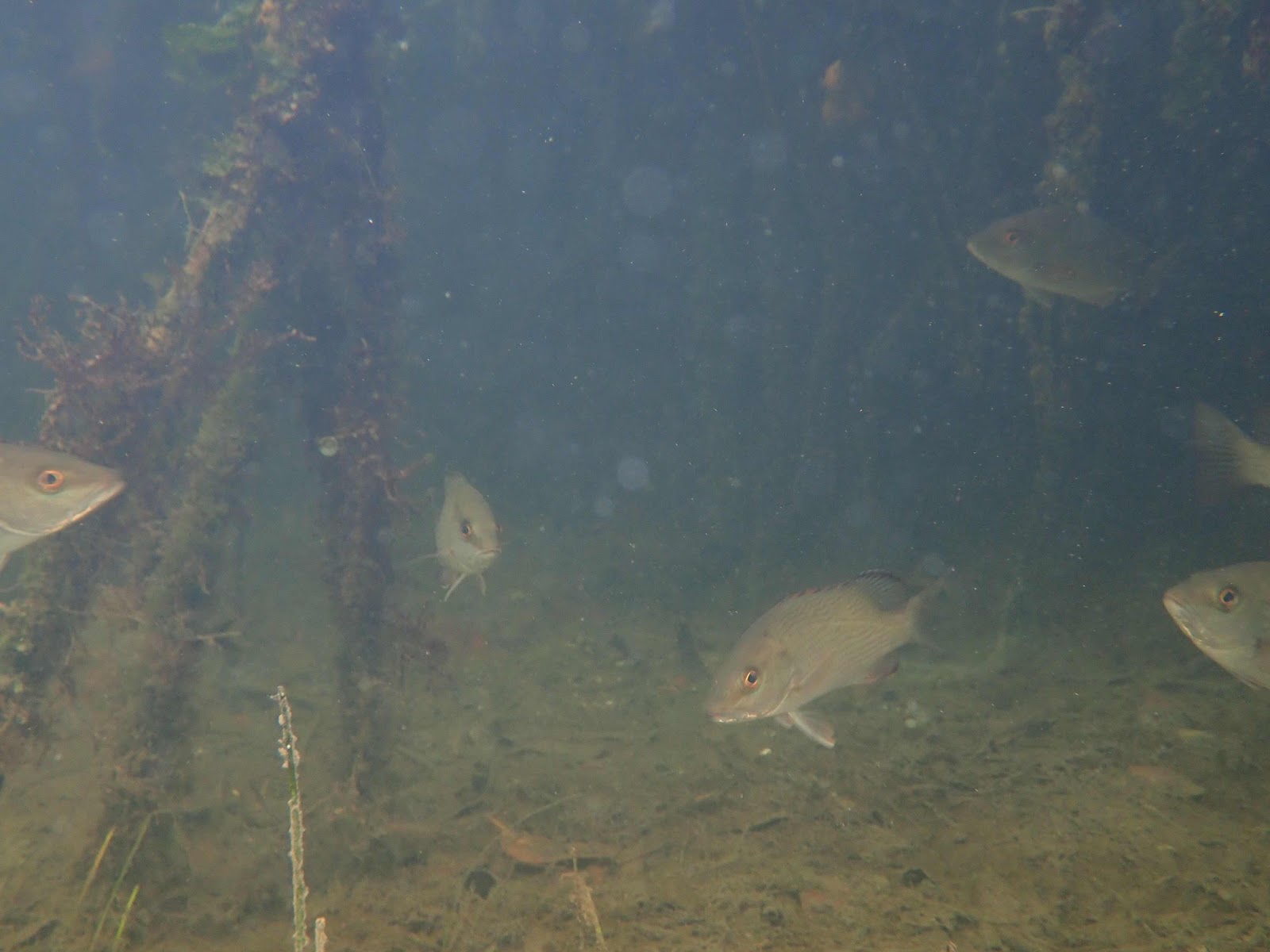I’m not talking about the decade, I’m talking about the temperature! We have had 7 consecutive days of 80+ degrees, and the forecast remains the same for the foreseeable future. It feels fantastic to get up every morning and dress in shorts and t-shirts!
We were anchored in Tarpon Basin in Key Largo for 6 days. We originally selected this anchorage for the great protection the mangroves offered from strong northerly and easterly winds, which blew for 5 days. It was also fairly deep (8 feet) for this area, which has been an eye opening experience. However, when we first arrived at the site and dropped the anchor we noticed a very strange sight. We always put the boat in reverse to slowly play out the anchor chain, but when Keith put the boat in reverse a cloud of sediment got swept up from the bottom, accompanied by dozens of jelly fish. Suddenly there were jellyfish everywhere when clearly there hadn’t been any before we put the boat in reverse. Once we got anchored and things settled down we could see the bottom again, and it looked like there were hundreds of upside down jellyfish on the bottom!

The wind was still strong so instead of snorkeling from the boat, we decided to take the Whaler to the mangrove line where the water was totally calm. We were also anxious to try out our new full face snorkel masks.

Cassiopea, also known as upside-down jelly fish. That Google is an amazing thing😏! I actually searched ‘upside down jellyfish’ and it popped right up. Here’s what Wikipedia says...
Cassiopea, also known as upside-down jelly fish. That Google is an amazing thing😏! I actually searched ‘upside down jellyfish’ and it popped right up. Here’s what Wikipedia says...
“Cassiopea (upside-down jellyfish) is a genus of true jellyfish and the only member of the family Cassiodeidae. They are found in warmer coastal regions around the world, including Florida, the Caribbean and Micronesia. The medusa usually lives upside-down on the bottom, which has earned them the common name. These jellyfish partake in a symbiotic relationship with photosynthetic dinoflagellates and therefore, must lay upside-down in areas with sufficient light penetration to fuel there energy source. Where found, there may be numerous individuals with varying shades of white, blue, green, and brown.”
That is too cool! If all jellyfish stayed on the bottom, and didn’t float around stinging people, they would be much more popular!
They do swim like ‘normal’ jellyfish if they get disturbed from the bottom (like when an idiot anchors on them and hits they with prop wash) or if they just need to move for better light. They are not attached to the bottom, and appear to only be resting there. However, even when they are on the bottom the medusa still pulsates gently.
A lonely starfish in a world of upside down jellys.

All sorts of interesting plants attach to the roots on the mangrove, especially on the outside edge where there is still plenty of sunlight.

You can clearly see the mangrove roots at the bottom of this picture. I will admit that I was not thrilled about swimming under the mangroves. I was very surprised to see that there was still 3-4 feet of water under the mangroves. They seem to be held up by the roots...I didn’t know that!

The fish love to hang out under the mangroves...me...not so much! When that ‘hairy root’ brushed my arm, I was out of there!

But Keith enjoyed hanging out in the dark with the fishes!

Once again it is time to move on. Today we are heading to Islamorada. The water is beautiful with, at least, 10 shades of blues and greens at any given moment.

The view straight down from the upper deck while underway. Clean water!

But VERY shallow! In my previous boating life I would get alarmed if the depth under our keel (which is 4.5 ft under the surface) went below 3 feet. If the depth finder read 2 feet I would usually decrease the throttle to idle speed and look to retreat, with serious concerns of running aground. Here we are surprised to see anything deeper than 6 feet (total) and running with only 1 foot under the keel has become our norm, but 3 inches was a first! I will confess to doing a happy dance when the depth returned to 12 inches under the keel.

This is what happens when we have less than 1.5 ft under the keel. You can see the path of sediment stirred up by our props.

I know you see a lot of dolphins, but this was a baby...and he/she jumped completely out of the water. It wasn’t until I downloaded the pictures did I realize that this baby has been hit by a boat. If you enlarge the picture you can see a clean cut in his dorsal fin, and prop marks of his back. After an experience like that, why would they want to chase our boat to play in the wave??

Anchored in Islamorada.




No comments:
Post a Comment